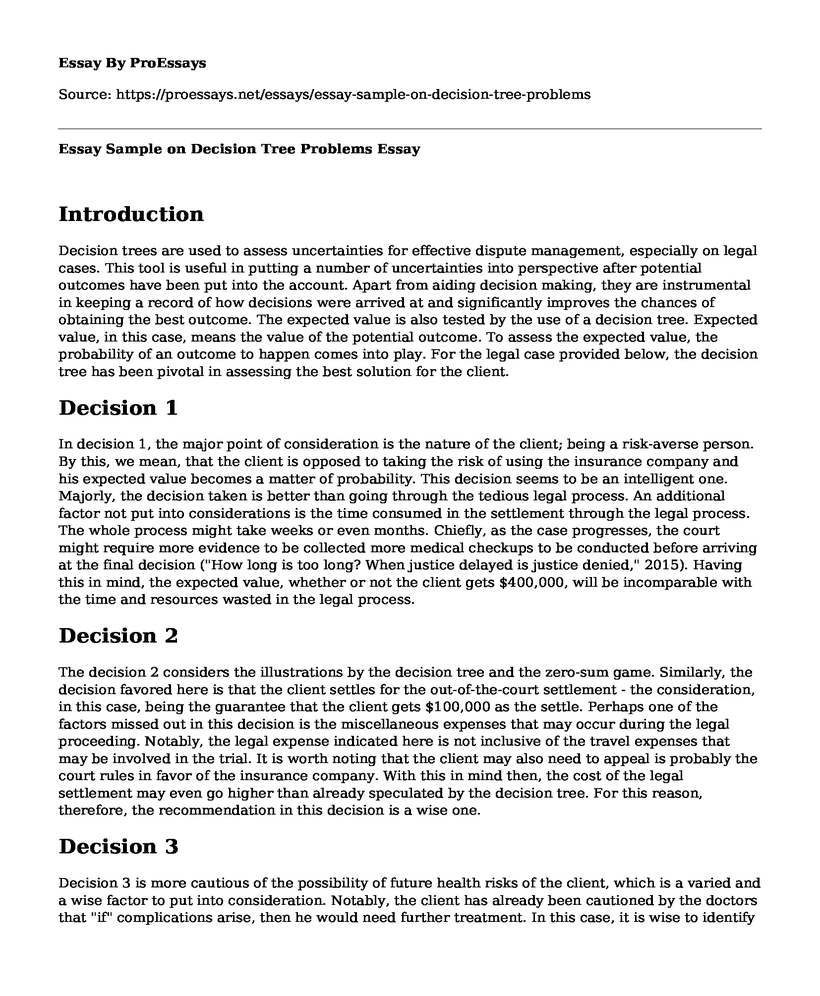Introduction
Decision trees are used to assess uncertainties for effective dispute management, especially on legal cases. This tool is useful in putting a number of uncertainties into perspective after potential outcomes have been put into the account. Apart from aiding decision making, they are instrumental in keeping a record of how decisions were arrived at and significantly improves the chances of obtaining the best outcome. The expected value is also tested by the use of a decision tree. Expected value, in this case, means the value of the potential outcome. To assess the expected value, the probability of an outcome to happen comes into play. For the legal case provided below, the decision tree has been pivotal in assessing the best solution for the client.
Decision 1
In decision 1, the major point of consideration is the nature of the client; being a risk-averse person. By this, we mean, that the client is opposed to taking the risk of using the insurance company and his expected value becomes a matter of probability. This decision seems to be an intelligent one. Majorly, the decision taken is better than going through the tedious legal process. An additional factor not put into considerations is the time consumed in the settlement through the legal process. The whole process might take weeks or even months. Chiefly, as the case progresses, the court might require more evidence to be collected more medical checkups to be conducted before arriving at the final decision ("How long is too long? When justice delayed is justice denied," 2015). Having this in mind, the expected value, whether or not the client gets $400,000, will be incomparable with the time and resources wasted in the legal process.
Decision 2
The decision 2 considers the illustrations by the decision tree and the zero-sum game. Similarly, the decision favored here is that the client settles for the out-of-the-court settlement - the consideration, in this case, being the guarantee that the client gets $100,000 as the settle. Perhaps one of the factors missed out in this decision is the miscellaneous expenses that may occur during the legal proceeding. Notably, the legal expense indicated here is not inclusive of the travel expenses that may be involved in the trial. It is worth noting that the client may also need to appeal is probably the court rules in favor of the insurance company. With this in mind then, the cost of the legal settlement may even go higher than already speculated by the decision tree. For this reason, therefore, the recommendation in this decision is a wise one.
Decision 3
Decision 3 is more cautious of the possibility of future health risks of the client, which is a varied and a wise factor to put into consideration. Notably, the client has already been cautioned by the doctors that "if" complications arise, then he would need further treatment. In this case, it is wise to identify the high risk and the lower risk. First, the risk or the probability of developing further complications cannot be substantiated. Therefore, the probability of even worse health complications could be even higher than the client knows. Since this risk is not quantifiable, and for what we know most patients develop complications such as Post Traumatic Stress Disorder (PTSD) after immediate treatment, then the client should most definitely prefer the legal process (Hickling & Blanchard, 1992). At least in such a decision, he knows the probabilities of the expected outcome.
Conclusion
In conclusion, decision trees are instrumental tools in making an informed decision in risk management. When making such sensitive decisions as the one highlighted above, it is key to put into consideration factors such as time, cost, expected value and the risk involved in any settlement. The ideal decision should be futuristic to avoid any regret in the future.
References
Hickling, E. J., & Blanchard, E. B. (1992). Post-traumatic stress disorder and motor vehicle accidents. Journal of Anxiety Disorders, 6(3), 285-291. doi:10.1016/0887-6185(92)90040-e
How long is too long? When justice delayed is justice denied. (2015, March 31). Retrieved from http://blogs.worldbank.org/europeandcentralasia/how-long-too-long-when-justice-delayed-justice-denied
Cite this page
Essay Sample on Decision Tree Problems. (2022, Nov 02). Retrieved from https://proessays.net/essays/essay-sample-on-decision-tree-problems
If you are the original author of this essay and no longer wish to have it published on the ProEssays website, please click below to request its removal:
- Paper Example on Leadership and Management
- Essay Sample on Community Prevention Program
- Narcissist and Covenant Leadership - Essay Sample
- Team Principles Essay
- Essay on Chairperson and Secretary: Setting the Agenda and Recording Minutes
- Essay Example on IT Governance: A Necessity for Effective Business Strategies
- Essay Sample on Building an Effective Team: More Than Just Hiring Right







